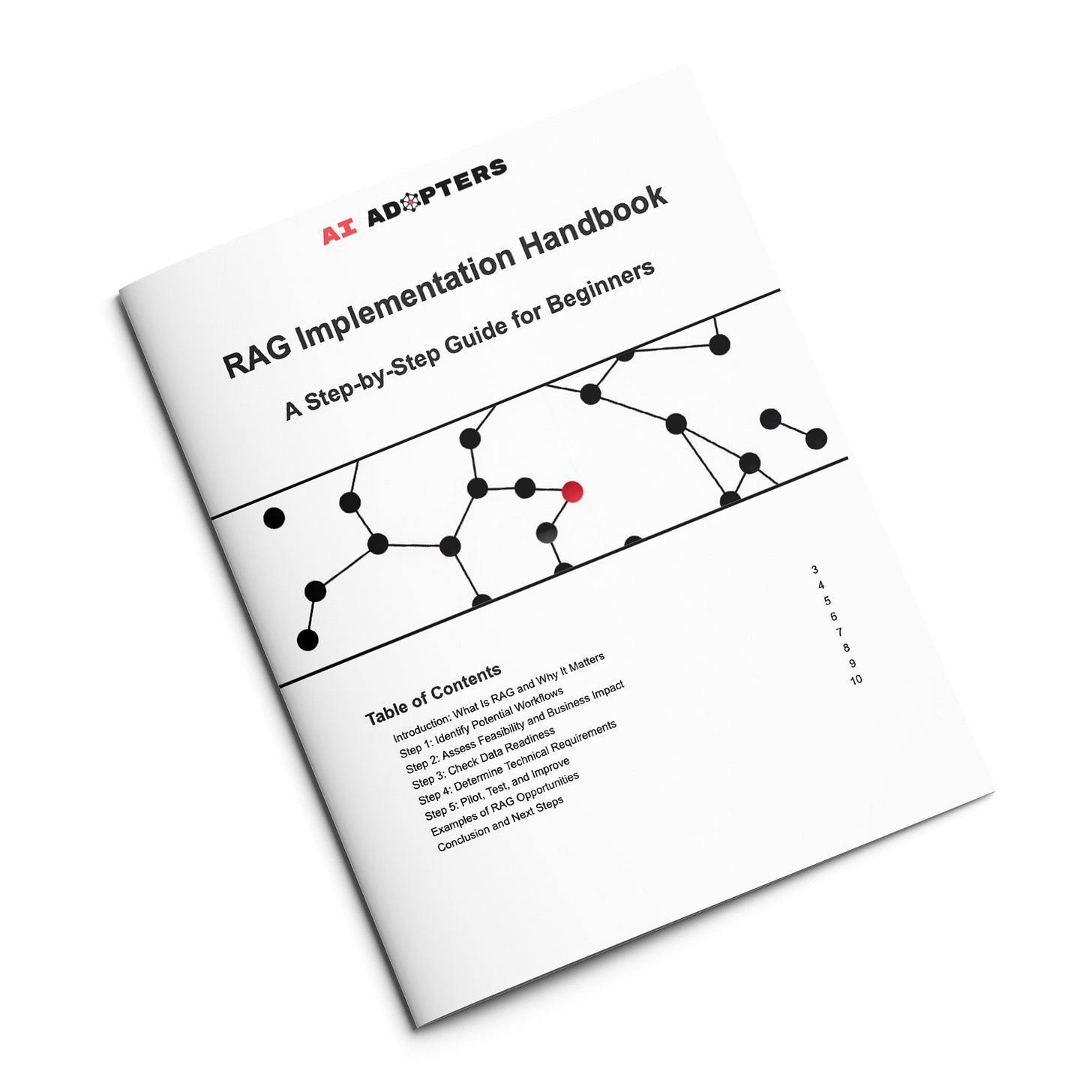Your Guide to Understanding AI's Most Practical Innovation
Demystifying RAG (Step by Step)
If you're looking to make AI work for your organization, there's a critical technology you need to understand: Retrieval-Augmented Generation (RAG). While it might sound technical, RAG is revolutionizing how businesses implement AI by solving one of its biggest challenges – making AI responses accurate, relevant, and grounded in your organization's reality.
What is RAG, and Why Should You Care?
At its core, RAG is an AI architecture that combines two powerful capabilities:
Retrieval: The ability to search and find relevant information from your organization's knowledge bases, documents, and databases
Generation: Using AI language models to create human-like responses based on the retrieved information
Think of it like having an extremely knowledgeable assistant who always checks your company's documentation before answering any question. Instead of relying solely on its training data, a RAG-enabled AI system actively searches through your organization's information to provide accurate, up-to-date answers.
The Business Case for RAG
Key Benefits That Matter to Your Organization
Enhanced Accuracy
Reduces AI "hallucinations" (generating incorrect or nonsensical outputs)
Grounds responses in your actual business data and documentation
Provides source attribution and citations, building trust in AI outputs
Real-Time Knowledge Access
Connects to live data feeds and frequently updated sources
Eliminates the need for constant AI model retraining
Ensures responses reflect your latest business information
Domain-Specific Expertise
Extends AI capabilities to your specific industry or organization
Leverages your internal knowledge base without extensive AI training
Adapts to your company's unique terminology and processes
Cost Efficiency
No need for expensive model retraining
Reduces time spent verifying AI outputs
Maximizes existing documentation and knowledge resources
Understanding Different Types of RAG Systems
Think of RAG systems like different levels of a customer service team. The most basic version, Simple RAG, is like having a helpful assistant who can quickly look up answers in a manual. You ask a question, they find the relevant information, and give you a straightforward answer. This works great for basic questions like "What's your return policy?" or "How do I reset my password?"
The next level, Simple RAG with Memory, is like talking to a service rep who remembers your whole conversation. If you ask about a product, then follow up with "How much does it cost?" and "Does it come in blue?", they remember you're still talking about the same item. This makes conversations feel more natural and saves you from repeating yourself.
Branched RAG is like having a senior specialist who knows how to handle complex questions that require checking multiple sources. If you ask something like "Which service plan would work best for my business?", they'll look up different plans, pricing, features, and requirements, then put it all together into a comprehensive answer.
Finally, Adaptive RAG is like having a seasoned expert who can handle any type of question. They automatically adjust their approach based on what you ask – using a quick lookup for simple questions, or doing deep research for complex ones. They know exactly how much effort each question needs and can respond appropriately.
Most businesses start with Simple RAG because it's effective and easier to implement. As their needs grow more complex, they can move up to more sophisticated versions. The key is matching the type of RAG to your actual business needs rather than jumping straight to the most complex option.
Real Businesses, Real Results: Success Stories
Thrive Market: Adaptive RAG for Smart Shopping
Thrive Market demonstrates a sophisticated implementation of Adaptive RAG in e-commerce. Their system handles varying levels of query complexity - from simple product searches to intricate dietary preference matching. The system adaptively switches between different retrieval strategies: it might perform a straightforward lookup for basic product information, but switches to complex, multi-factor analysis when making personalized recommendations. For example, when a customer shops for pasta, the system not only checks their gluten preferences but also analyzes past purchases, dietary restrictions, and complementary products like sauces or seasonings they might enjoy. This adaptive approach has led to higher sales and significantly improved customer satisfaction.
BloomThat: RAG with Memory for Personalized Florals
BloomThat's implementation showcases RAG with Memory in action. Their system maintains ongoing context about customer preferences and past interactions, creating what they call "preference profiles." When a customer returns to place a new order, the system remembers their style preferences, previous purchases, and even special occasions they've ordered for in the past. By maintaining this conversational memory, the system can make increasingly refined suggestions over time. For instance, if a customer previously ordered bright, colorful arrangements for spring occasions, the system remembers this preference when making future recommendations, while also incorporating new data from their social media interactions to keep preferences current.
ManyChat: Simple RAG with Memory for Small Business Support
ManyChat chose to implement Simple RAG with Memory to create accessible chatbot solutions for small businesses. Their system demonstrates how effective even a straightforward RAG implementation can be when well-executed. The chatbots can handle sequential customer inquiries by maintaining context throughout the conversation - if a customer asks about product availability, then pricing, and then shipping, the system remembers the specific product being discussed. This approach strikes an ideal balance: it's sophisticated enough to maintain natural conversations but simple enough for non-technical business owners to set up and manage. The result is an affordable solution that allows small businesses to provide 24/7 customer service without the complexity of more advanced RAG implementations.
Each of these cases shows how different types of RAG can be matched to specific business needs. Thrive Market's complex recommendation engine required Adaptive RAG's sophisticated capabilities, while ManyChat achieved significant results with a simpler implementation. BloomThat's middle-ground approach with RAG with Memory proved perfect for their customer-centric business model. These examples demonstrate that success with RAG isn't about choosing the most advanced version, but rather selecting the type that best fits your specific business challenges and technical capabilities.
Understanding RAG's Limitations
While RAG is powerful, it's important to understand its constraints:
Data Quality Dependencies
Results are only as good as your source documents
Requires well-organized, accurate information
Need for regular content updates
Technical Considerations
Computing resources required for efficient retrieval
Need for proper data indexing and search mechanisms
Integration requirements with existing systems
Implementation Challenges
Initial setup and configuration complexity
Need for balanced retrieval strategies
Ongoing maintenance and optimization
Tools and Technologies
Several tools and platforms are available for implementing RAG:
Development Tools
• LangChain: Popular framework for building RAG applications.
• LlamaIndex: Toolkit for data connection and indexing.
• Hugging Face Transformers: Provides access to pre-trained models.
Cloud Services
• AWS RAG solutions: Comprehensive cloud infrastructure for RAG.
• Google Cloud’s AI platforms: Advanced AI services tailored for RAG implementations.
• Azure Cognitive Services: Scalable AI tools for building intelligent applications.
Specialized Platforms
• Vectara: Offers a “RAG in a box” approach for enterprise solutions.
• Personal AI: Privacy-focused RAG platform with advanced features.
• ChatPDF: Specialist in document interaction and conversational PDF querying.
RAG represents a practical approach to making AI work in real business contexts. By understanding its capabilities, limitations, and implementation requirements, you can become a valuable resource in your organization's AI journey. The key is to start small, focus on quality data, and build on successes.
Ready to Implement RAG in Your Organization?
Transform this knowledge into action with our step-by-step RAG Implementation Handbook. As an AI Adopters Club Premium subscriber, you'll get:
Complete implementation framework with action steps
Evaluation tools and project roadmaps
Expert tips and pitfall warnings
Skip the trial and error. Get the blueprint that's helping managers become AI champions in their organizations.
Get Your RAG Implementation Handbook 👇






